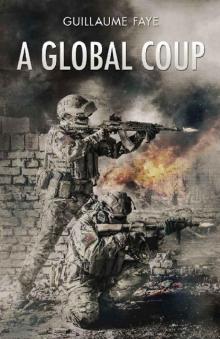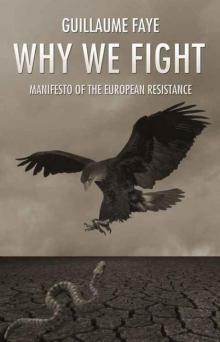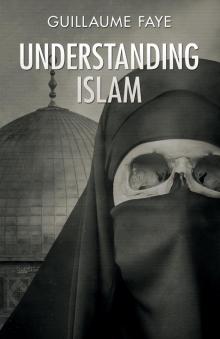Convergence of Catastrophes, page 12




* * *
An ideological reversal is occurring in the French Jewish community because of the rise of a very strong North African anti-Judaism in France. The article ‘Eurabia: A New Civilisation’ in Israel Magazine (April 2003) opines: ‘Europe has abandoned the Christians of Lebanon to Palestinian massacres and the Christians of the Islamic world to persecutions by Islamists. . . . On the European demographic level, the immigration policies of the European Union have encouraged the Islamist desire to Islamicise Europe. The real numbers of this immigration has been kept from the public. For the only time in the history of immigration, exporting the culture of immigrants into the countries that welcomed them was written into the accords between the EU and the Arab League[126] as an unalienable right of immigrants. . . . The European Saint-Justs[127] of anti-racism have succeeded in eliminating all discussion concerning the danger, criminal activity and fanaticism of a population that refuses to integrate.’
The author, Bat Ye’or,[128] who also writes for the influential Observatoire du monde juif, defends the thesis of the coherent solidarity of Jews and Europe, an alliance of Israel and Europe, deplores Europeans’ pro-Arab policies and blames them in the following terms for Arab Islamism that she calls the principal enemy: ‘The contempt for “infidel” Judaeo-Christian culture is expressed in the affirmation of the superiority of Islamic civilisation, from which European scholars have humbly drawn. This absurdity, repeated obsequiously by our European ministers, constitutes in fact a religious principle of the Arab world, which recognises no superiority in the civilisation of the “infidels.” . . . Veneration of the myth of Andalusia[129] replaces scholarly knowledge of the devastating Muslim invasions.’ Bat Ye’or goes even further: ‘Since the 1970s, immigration policies, integrated in the economic and political conception of EAD (Euro-Arab Dialogue), has been planning a homogeneous implantation into the secular European tissue of foreign communities numbered in the millions, who have come, not to assimilate, but to impose their own civilisation by right in the countries that welcome them. . . . From the beginning of immigration, assimilation was excluded, even while EAD was demanding for Arab immigrants rights conferred by European institutions, which the immigrants rejected since they privileged their own Arab Islamic culture founded on shariah.’
An analysis like this denotes a nearly complete reversal in the opinion of the Jewish community on the subject of Arab Islamic immigration-colonisation. Ideologies and customs always collapse under the pressure of facts. It will be important to very seriously analyse this radical change of opinion.
* * *
The prelude to civil war is extending the domain of the struggle. Everywhere in France the areas of criminal activity of ‘ethnic bands’ are spreading, dominating the countryside and formerly peaceful quarters of cities and are no longer limited to ‘sensitive quarters’. We are dealing with a strategy that operates by expanding the areas of criminal activity in a carefully thought-out strategy of civil war.
In Marseilles, for example, cars are burning in the southern quarters, which had been spared up to now. The regional press, on 19 January 2004, reveals that four vehicles were set on fire without provocation in the sixth and seventh arrondissements[130] and two others in the eighth. Dominique Tain, Deputy Mayor of the sixth and seventh arrondissements, deplores ‘a rise in violence, of violent deeds, an increase in delinquency, mob activities in front of schools . . . in the southern quarters.’ On 29 December 2003, a merchant was mugged in broad daylight on rue W. Puget. More interesting: on 4 January 2004, the large wooden crucifix that rises above the monument to the dead of Saint-Giniez was burned. On 9 February, a 57-year-old retired teacher, who took care of the church of Saint-Cannat without pay, was found stabbed to death near the baptismal font. And that’s not all. In the same vein: on January 18, on the rue Fort-du-Sanctuaire, which leads to the church of Notre-Dame-de-la-Garde, tourists and pilgrims were greeted with the sight of two vehicles that had just been set on fire. When will they set fire to Notre-Dame-de-la-Garde? We could make certain suppositions about the identity of those who ordered these acts of ‘uncivil disobedience’ and the ones who perpetrated them.[131]
* * *
What is this kind of vandalism? There is little public discussion of it, but vandalism is an increasingly serious scourge, as damaging as violent crime. Let us not talk only of the countless vehicles set on fire, but also of the destruction of gymnasiums and public swimming pools, acts of arson against public buildings, the massive theft of materials, the damage inflicted on public buildings, and so on. These acts have multiplied significantly over the past three years and so has their cost. Let us take the example of Marseilles: according to La Provence (7 October 2003): ‘The bill has arrived for the municipality: about 1.86 million euros a year, or 12.5 million francs’, drawn from the local taxpayers, without counting the expenses of guards and security of 140,000 euros. The local press obviously does not bother to mention the ethnic origin of these ‘vandals’ other than with the expression ‘urban youth’. This criminal activity, which is increasing all over France, represents a growing burden for the French economy.
* * *
The slums are arming themselves. The authorities have stopped counting the muggings, hold-ups, and riots that increasingly involve military weapons: hand grenades, rocket launchers, assault rifles, and so on. Criminologist Xavier Raufer[132] declared in La Provence (30 December 2001), ‘Arms trafficking never stops growing, particularly from the Balkans. The hot slums have been teeming with heavy weapons for about two years. These military weapons are conveyed into France by criminal elements from Serbia and Croatia or the Albanian mafia. But gun trafficking only exists because it is answering a growing demand, especially on the part of criminal “start-ups”, groups of urban delinquents on the way to organised crime.’ This arsenal is not only useful for attacking armoured cars; it is a preparation for civil war. It is not at all certain that the local police are prepared, or the state police or even the army . . .
* * *
First cars are set on fire, then apartment buildings. In Chalon-sur-Saône, on the night of 8 to 9 February 2002, ‘youths’ innovated. After a night of rioting — provoked in the classic scenario by the (failed) arrest of hoodlums who attacked the Vox cinema to rob the box office — an apartment house was burnt to the ground, along with a brush factory. More seriously, in the Fontaine-au-Loup quarter, apartment houses were threatened by burning garbage cans that had been doused with petrol and set on fire. People living on the waterfront succeeded in putting the fires out without help, because the firemen were pelted with stones and could not get to the buildings. Naturally, the Chalon public prosecutor’s office released the ten rioters who had been arrested.
During the night of 2-3 March, in addition to burning a dozen cars, rioters set fire to the entryway and a staircase of an apartment in the ‘inner city’ of Strasbourg, Arago Square. The apartment’s inhabitants had to move to new dwellings. At 9:40 PM on rue Augustin-Fresnel in Cronenbourg, the fire from burning cars spread to the lower floors of apartment houses. On rue Becquerel, the riot police (CRS)[133] managed to put out several fires set in apartment basements.
In the village of Pujaut in the Gard department in southern France, on 4 March 2004, a retired couple’s farmhouse in the scrubland was attacked by a band of ‘youths’ whose origin there is no need to mention. The couple were ‘tied up like sausages’ and beaten, their credit cards stolen after they revealed the passwords under duress, and their house was pillaged and devastated before their eyes. The perpetrators then burned the farmhouse and a nearby tenant’s house and sadistically forced the retired couple to watch their property going up in smoke, threw their dog into the burning coals and then shut the couple up in the pigpen. They barely survived the ordeal.
One more step has been taken on the road to a future ethnic civil war. There can be no mistake. We are soon going to see massive attacks on the downtowns of large cities, towns and isolated properties where buildings will be burned, and all this even in the ‘nice parts’ of town.
* * *
The slums are suffering from ‘amateur’ terrorist attacks. Naturally the media do not talk much about them. We are witnessing a rise in attacks with explosives for which no one claims credit, especially in France. Three cases took place at the end of December 2003 and January 2004 involving homemade bombs: 1) at Belfort, a bomb exploded in front of the Maison de l’information sur la formation et l’emploi in the ‘problem area’ of les Résidences, following two criminal incendiary acts against public buildings with significant damage; 2) the Youth Culture Centre (MJC) of Mulhouse — again in a problem area — was attacked by a bomb (using a fire extinguisher filled with explosives), probably because it had been closed following incidents between ‘youths’ and educators; 3) in Montgeron (in the south of the Parisian slums) the façade of a high school gymnasium was completely levelled by a bomb. The school’s administration expressed its ‘surprise’ and explained, ‘no recent incident could explain an act of vengeance or of reprisals.’
In reality, this is the beginning of guerrilla warfare. For the time being, there have been no human victims, but that will come . . . These apprentice terrorists (in fact, who are they imitating?) are increasingly proficient in the use of explosives. It is going to get worse . . .
* * *
France is not the only country where firemen are stoned and attacked. In Great Britain, in 2001, there were reports of 161 attacks against firemen, when they came to fight car fires that had been deliberately lit. On 19 September 2003, in the Blackhill neighbourhood of Glasgow, a group of firemen were attacked with knives and incendiary devices. Many firemen were seriously wounded. In the suburb of Maryhill, ten-year-old children threw Molotov cocktails at fire trucks. The local captain of the firefighters responded, ‘I am flabbergasted. There are more and more of these attacks. Why?’ ‘Political Correctness’ will never supply an answer.
Firemen (like the police) symbolise a ‘native-born uniformed authority’. The British communitarian model does not work better than French-style compulsory assimilation. This is obviously anti-European racist activity. The highbrow sociologists do not see it, but ordinary people do, perhaps . . .
* * *
Let us recall the affair of the attack on the ‘supercops’ of the GIPN.[134] In Briançon, on Tuesday, 25 November 2003, a squad of elite police from the GIPN arrived from Nice to subdue a madman who was shooting wildly. The operation was successful. The madman was brought to the psychiatric hospital of Laragne-Montéglin. When the operation was finished, about fifteen policemen, still in uniform, headed for a restaurant. They were then insulted and attacked for no particular reason by what was called ‘a band of youths’. It ended in a general brawl and various injuries. No one was arrested, despite the help of police from the local commissariat. The self-righteous newspaper La Provence (27 November 2003) suggests, ‘It was the GIPN members who caused the skirmish.’ Of course, no doubt about it! It was the police who provoked the ‘youths’ by walking around in uniform. This business, which Maurice Fortoul of La Provence called ‘a rather surprising incident’, will surprise only the blind.
* * *
A confidential report (28 July 2003) of the DCRG[135] was devoted to the alarming increase in attacks on off-duty police. The national origin of these attackers is never mentioned, but may be suspected. The report says, ‘Attacks on off-duty police, beyond the symbolic challenge to public institutions, expresses a true hatred of authority and civil servants become the victims. Sometime the explanation may be a desire for revenge of the part of the delinquents who meet an official who participated in their arrest or in court proceedings that involved them.’
The report mentions an increase in the following: 1) very violent ambushes against police who are returning home; 2) attempted vehicular homicide of police both in uniform and plain clothes, even if the attacker was never involved with the victim; 3) brutal attacks on the family or relatives of police (including sexual assaults on policemen’s wives) when it is learned that ‘so-and-so is a policeman’; 4) attacks on young ADS[136] or beat cops ‘coming from the projects’ (that is, from immigrants). These events are accompanied by racist comments and graffiti. They are typically the first steps to civil war.
The report also points out ‘the uneasiness of communities in the face of summer violence. They have become the theatre for clashes between rival gangs . . . which tarnish the celebrations of the end of the summer season. Since they cannot assure security at the events, elected officials and organisers have cancelled certain celebrations.’ In fact, a number of long-established traditional festivals have one after another been suppressed. Was this not the goal of the violence?
The report also notes the spoiling of popular French vacation areas (this, of course, is not true of stylish areas, which are heavily protected): ‘Commonly, with the large crowds of vacationers that go to the seaside, combined with the arrival of youths from problem areas encouraged by the operation “Ville Vie Vacances”, which promotes seaside vacations for urban youth, seaside areas that were once peaceful and crowded with families now experience “significant acts of street crime.”’ VVV is a lovely initiative, where small-time drug lords, supervised well or ill, are rewarded with vacations at taxpayers’ expense . . . When will the French people finally have enough?
* * *
It is often said that in the ‘problem developments’ the young burglars and punks are ‘only a handful, a minority’, implying that with a few more arrests and tougher laws the police could immediately restore order and that the threat is basically minimal. Uneasy at the multiplication of large and violent gangs, sociologist Bjarne Melkevik notes the unstoppable growth of a ‘subculture of violence’, that is increasingly widespread among young Africans from the Maghreb in Violence et délinquance des jeunes.[137] Demonstrating that the phenomenon is not at all marginal, sociologists Sophie Body-Gendrot and Nicole Le Guennec, in a report on urban violence submitted to the government in May 2001, explain, ‘In a housing project (ZUP) of 28,000 inhabitants like Le Val-Fourré or Mantes de Jolie, 11,000 youths are all potential rioters.’ In other words, in a ‘normal’ situation the police should confront fewer than 100 hoodlums. These 100, however, will be ‘officers’ who are training several thousand assailants. Then, if for each ZUP we count 11,000 ‘combatants’, in France as a whole, if a riot breaks out, there must be many more than a million potential rioters! The urban police, the CRS and the state police would be unable to deal with them. It is no longer a police situation of maintaining order, but a military situation of open war. The government knows this. This is why it is doing everything possible to ‘buy’ peace in the slums and towns. They are moving back to jump farther. The preventive measures they are taking will not stop a spark from provoking a simultaneous and generalised insurrection in developments that will look just like a civil war.
* * *
In Belgium, the Islamists form a state within the state. A report of the Belgian parliamentary commission that specialises in education observes the following facts: the secret services have discovered that the ‘hardcore’ Islamist network Salafi, based in Saudi Arabia, ‘has created a virtual secret religious state inside the Kingdom of Belgium’, with an ‘Islamic police’ that enforces respect for Islamic laws and punishes drug dealers, pimps and Arab merchants of alcohol. Among its other activities are the diffusion of cassettes of Bin Laden and pro-terrorist preachers, and paramilitary training and parachute jumps in the Ardennes forest. The 350,000 Muslims of Belgium are the target of this organisation that aims at fanaticising them. The good deputies and senators of Belgium fear that these Islamists ‘are destroying the work of assimilation achieved by the government’ and that ‘this fifth column may perform dangerous acts if the conflict in the Middle East gets worse.’ The report concludes, ‘Belgium has become a central logistical base for terrorist groups like Al Qaeda, the Algerian GIA, Wahabi Tabligh, the Palestinian Hamas and the Egyptian Muslim Brotherhood.’ Armand de Decker, President of the Belgian Senate, declared, ‘Many of these groups are in the process of trying to re-Islamicise the Muslim population of Belgium in the most radical direction.’
Similarly, the ‘Arab-European League’ directed from Saudi Arabia (its Pakistani terrorist section is Rabita Trust), threatens the Belgian government on the Internet with establishing Islamic power structures in Belgium and Europe. Islamist residents have understood perfectly that Belgium, a weak state that is the home to European Union institutions, is an ideal entry door to conquer Europe.[138] What does the Islamophile Louis Michel[139] think of all this?



















